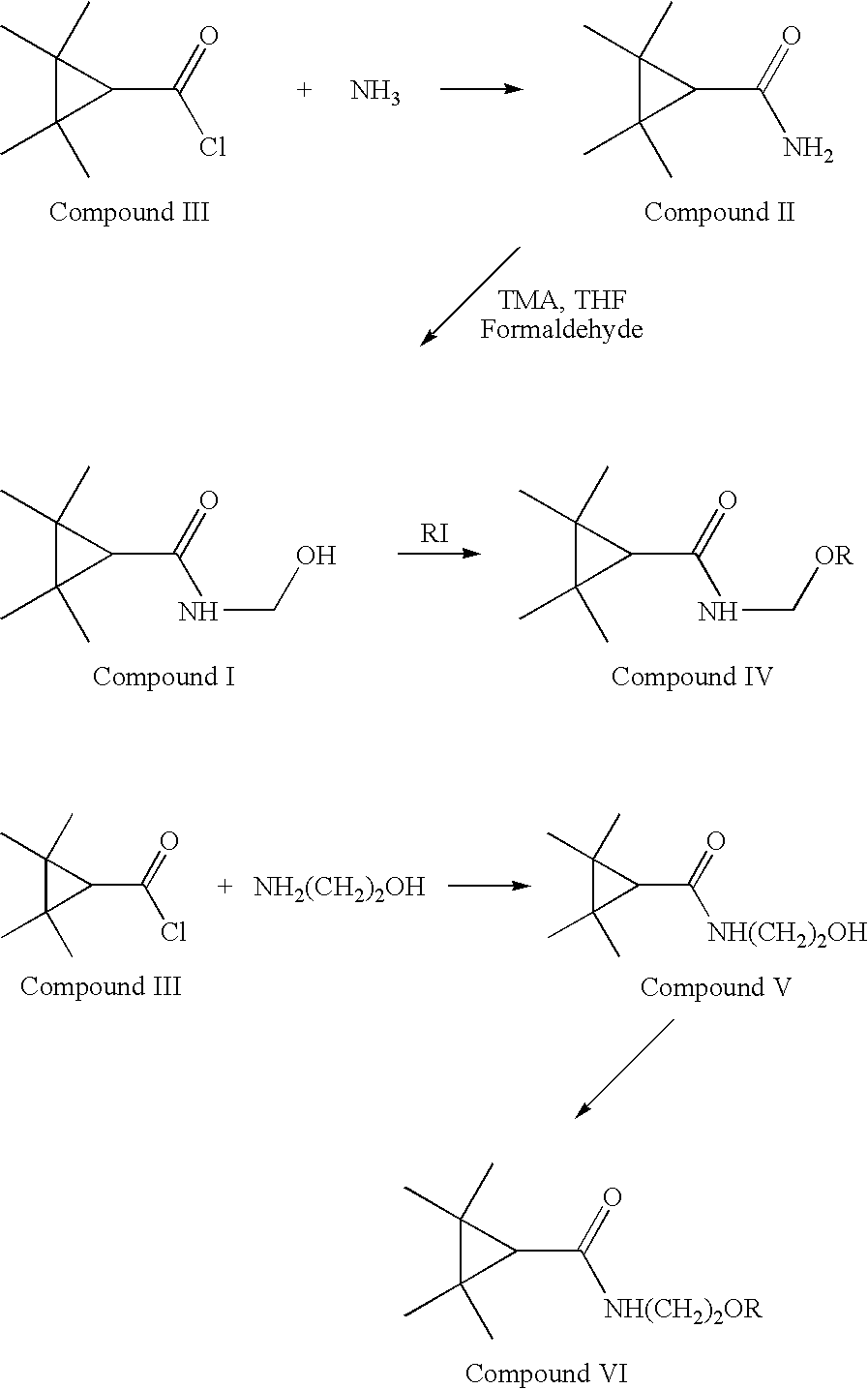Derivatives and pharmaceutical compositions of n-hydroxyalkyl tetramethylcyclopropane-carboxamide, having anti-epiletic, neurological, and CNS activity, and method for their preparation
a technology of n-hydroxyalkyl tetramethylcyclopropane and carboxamide, which is applied in the directions of amide active ingredients, biocide, organic chemistry, etc., can solve the problems of limiting the use of valproic acid, 25% of patients not responding to current medications, and considerable adverse effects of valproic acid itsel
- Summary
- Abstract
- Description
- Claims
- Application Information
AI Technical Summary
Benefits of technology
Problems solved by technology
Method used
Image
Examples
example 1
[0033]Tetramethyl-cyclopropane-carbonylchloride (15 g, 0.093 mol) was added dropwise to a 25% aqueous solution of ammonia (100 mL) at ambient temperature. The two-phase mixture was stirred at RT overnight. 100 mL of water was then added and the aqueous layer extracted with DCM (2*200 mL). The combined organic layers were washed successfully with carbonate buffer, dried and evaporated to dryness. The residue was treated with chloroform:hexane (100 ml), and the resultant chrystals were collected by filtration washed with hexane and dried to give 10 g (0.071 mol, 76%) of the title compound as a white solid, mp 90° C.
example 2
[0034]4 g, 0.028 mol of Tetramethyl-cyclopropane-carboxamide (compound II) prepared according to Example 1 was added to a solution of Trimethylamine (20 mL) and formaldehyde (20 mL) in tetrahydrofurane (100 ml). The reaction mixture was stirred in 60° C. for 12 hours. The excess of THF and formaldehyde was then distilled using reduced pressure and the residue containing the product N-hydroxymethyl-tetramethylcyclopropane-carboxamide (compound I) treated with CHCl3. The resultant crystals were collected by filtration washed with hexane and dried to give 3 g (0.175 mol, 63%) of the title compound as a white solid, mp 135° C.
example 3
[0035]Compound I (of the above diagram) was screened for its ability to protect against chemically and electrically induced convulsions, in three models of epilepsy in rodents. The first model, the maximal electroshock seizure test (MES), is used to show efficacy for antiepileptic agents against partial and generalized seizure type epilepsy, the common epilepsy among therapy resistant epileptic patients. The second model, the subcutaneous metrazole test (sc Met) measures seizure threshold and is a standard screening procedure to show efficacy for agents against seizure threshold and absence seizures. The third model is the 6 Hz psychomotor seizure model, a model that screens for focal seizures and has been used to find new antiepileptic compounds with novel mechanisms of action. In these studies, convulsions were inhibited or prevented in mice following imtraperitoneal (ip) administration of compound 1.
[0036]N-Hydroxymethyl-tetramethylcyclopropane-carboxamide (com...
PUM
| Property | Measurement | Unit |
|---|---|---|
| temperature | aaaaa | aaaaa |
| pharmaceutical composition | aaaaa | aaaaa |
| composition | aaaaa | aaaaa |
Abstract
Description
Claims
Application Information
 Login to View More
Login to View More - R&D
- Intellectual Property
- Life Sciences
- Materials
- Tech Scout
- Unparalleled Data Quality
- Higher Quality Content
- 60% Fewer Hallucinations
Browse by: Latest US Patents, China's latest patents, Technical Efficacy Thesaurus, Application Domain, Technology Topic, Popular Technical Reports.
© 2025 PatSnap. All rights reserved.Legal|Privacy policy|Modern Slavery Act Transparency Statement|Sitemap|About US| Contact US: help@patsnap.com



